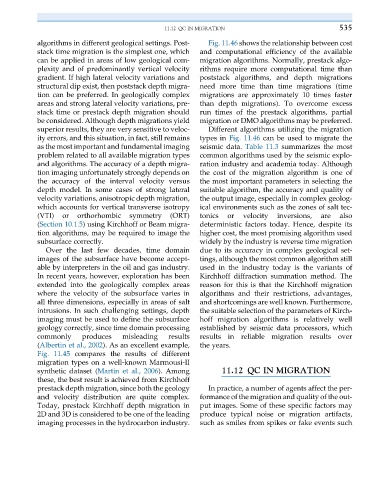Page 544 - Acquisition and Processing of Marine Seismic Data
P. 544
11.12 QC IN MIGRATION 535
algorithms in different geological settings. Post- Fig. 11.46 shows the relationship between cost
stack time migration is the simplest one, which and computational efficiency of the available
can be applied in areas of low geological com- migration algorithms. Normally, prestack algo-
plexity and of predominantly vertical velocity rithms require more computational time than
gradient. If high lateral velocity variations and poststack algorithms, and depth migrations
structural dip exist, then poststack depth migra- need more time than time migrations (time
tion can be preferred. In geologically complex migrations are approximately 10 times faster
areas and strong lateral velocity variations, pre- than depth migrations). To overcome excess
stack time or prestack depth migration should run times of the prestack algorithms, partial
be considered. Although depth migrations yield migration or DMO algorithms may be preferred.
superior results, they are very sensitive to veloc- Different algorithms utilizing the migration
ity errors, and this situation, in fact, still remains types in Fig. 11.46 can be used to migrate the
as the most important and fundamental imaging seismic data. Table 11.3 summarizes the most
problem related to all available migration types common algorithms used by the seismic explo-
and algorithms. The accuracy of a depth migra- ration industry and academia today. Although
tion imaging unfortunately strongly depends on the cost of the migration algorithm is one of
the accuracy of the interval velocity versus the most important parameters in selecting the
depth model. In some cases of strong lateral suitable algorithm, the accuracy and quality of
velocity variations, anisotropic depth migration, the output image, especially in complex geolog-
which accounts for vertical transverse isotropy ical environments such as the zones of salt tec-
(VTI) or orthorhombic symmetry (ORT) tonics or velocity inversions, are also
(Section 10.1.5) using Kirchhoff or Beam migra- deterministic factors today. Hence, despite its
tion algorithms, may be required to image the higher cost, the most promising algorithm used
subsurface correctly. widely by the industry is reverse time migration
Over the last few decades, time domain due to its accuracy in complex geological set-
images of the subsurface have become accept- tings, although the most common algorithm still
able by interpreters in the oil and gas industry. used in the industry today is the variants of
In recent years, however, exploration has been Kirchhoff diffraction summation method. The
extended into the geologically complex areas reason for this is that the Kirchhoff migration
where the velocity of the subsurface varies in algorithms and their restrictions, advantages,
all three dimensions, especially in areas of salt and shortcomings are well known. Furthermore,
intrusions. In such challenging settings, depth the suitable selection of the parameters of Kirch-
imaging must be used to define the subsurface hoff migration algorithms is relatively well
geology correctly, since time domain processing established by seismic data processors, which
commonly produces misleading results results in reliable migration results over
(Albertin et al., 2002). As an excellent example, the years.
Fig. 11.45 compares the results of different
migration types on a well-known Marmousi-II
synthetic dataset (Martin et al., 2006). Among 11.12 QC IN MIGRATION
these, the best result is achieved from Kirchhoff
prestack depth migration, since both the geology In practice, a number of agents affect the per-
and velocity distribution are quite complex. formance of the migration and quality of the out-
Today, prestack Kirchhoff depth migration in put images. Some of these specific factors may
2D and 3D is considered to be one of the leading produce typical noise or migration artifacts,
imaging processes in the hydrocarbon industry. such as smiles from spikes or fake events such

